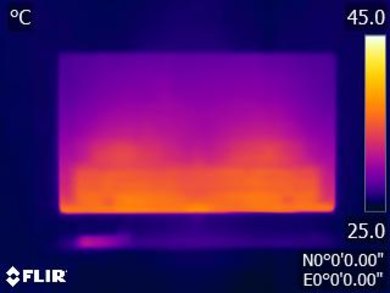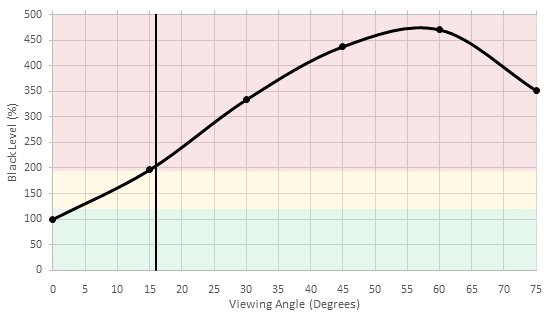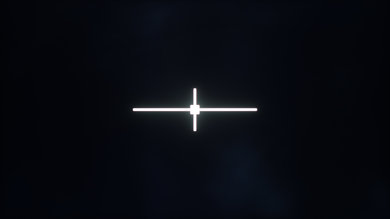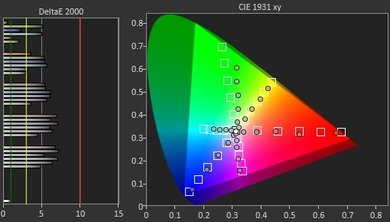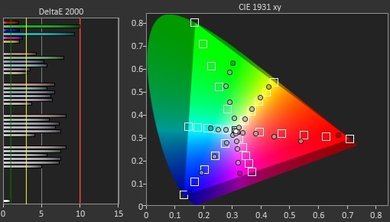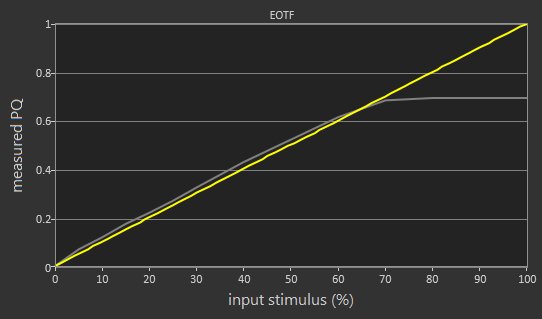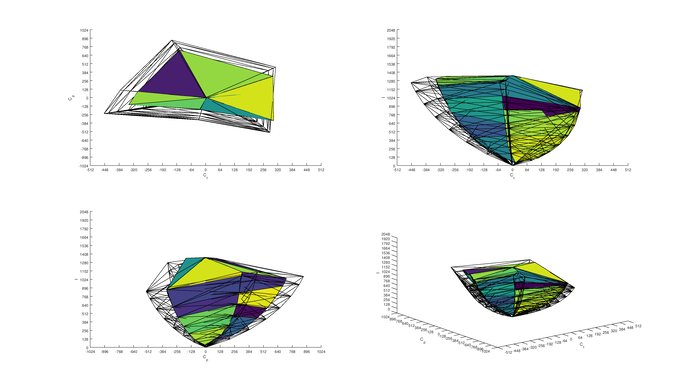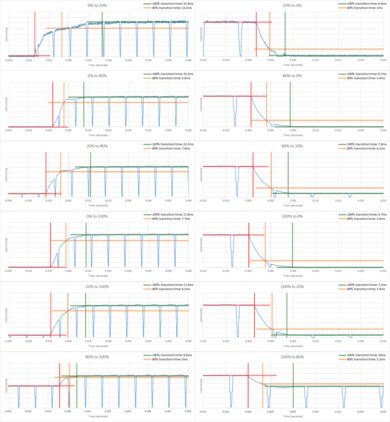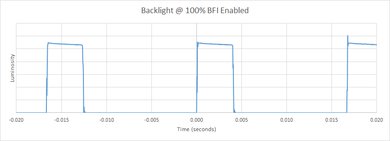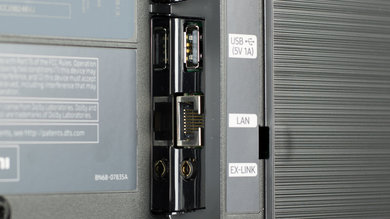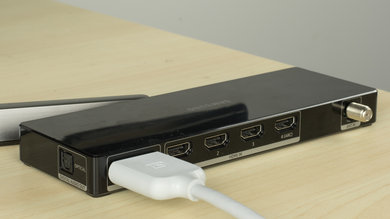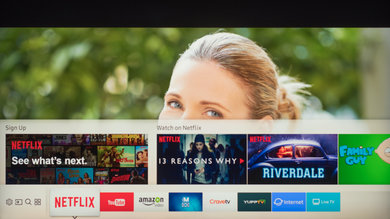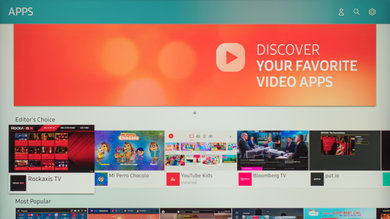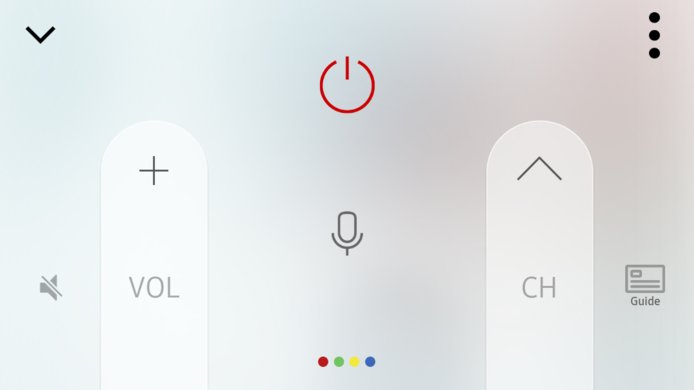Our Verdict
Great TV for a range of uses. Produces deep blacks, even in a well-lit room due to the excellent anti-reflection coating. Can get bright and product a wide range of colors. Motion handling is great, with only a short trail following fast objects. Unfortunately the image accuracy degrades when viewed at an angle.
- Great dark scene performance
- Feels very responsive
- Can get bright
- Images loses accuracy at an angle
- Poor local dimming
Great for movies in a dark room. Very good picture quality with deep blacks, and uniformity is good. Has a local dimming function, but it doesn't work well and results in vertical blooming. 24p content is smooth.
Good for casual TV watching in a bright room. Deals with reflections well, and can get bright to overcome glare. Unfortunately the image accuracy degrades at an angle.
Good for sports fans. Motion handling is great due to the fast response time. Can get bright to overcome glare, and picture quality is very good. Unfortunately for wide seating the image quickly loses accuracy when viewed at an angle.
Great for gamers. Low input lag and great motion handling so TV feels very responsive. Picture quality is very good.
Great for watching HDR movies in a dark room. Very good picture quality with deep blacks and good uniformity. Can produce a wide range of colors and get bright, but unfortunately the local dimming doesn't work well to improve dark scene performance further.
Great for HDR gaming. Picture quality is very good, and motion handling is great. Feels responsive with low input lag. Can produce bright, vivid highlights.
Decent PC monitor. Very good picture quality, but when close to the screen the edges lose accuracy due to the poor viewing angle. Feels very responsive with low input lag and great motion handling.
Changelog
- Updated Mar 30, 2018: It was discovered that many 2017 Samsung TVs change their BFI frequency to 60 Hz when a lot of 60 Hz motion is detected on screen. The scores have been updated.
- Updated Mar 12, 2018: Converted to Test Bench 1.2.
- Updated Aug 10, 2017: Converted to Test Bench 1.1.
- Updated Jul 17, 2017: Review published.
Check Price
Differences Between Sizes And Variants
We tested the 55" (UN55MU9000) version FA01. For the most part, we expect our review to be valid for the 65" version (UN65MU9000) and 75" version (UN75MU9000). If someone comes across a different type of panel or if their Samsung MU9000 doesn't correspond to our review, let us know and we will update the review.
| Size | Model | US | Canada | UK |
| 55" | UN55MU9000 | UN55MU9000FXZA | UN55MU9000FXZC | UE55MU8000 |
| 65" | UN65MU9000 | UN65MU9000FXZA | UN65MU9000FXZC | UE65MU8000 |
| 75" | UN75MU9000 | UN75MU9000FXZA | UN75MU9000FXZC | UE75MU8000 |
Popular TV Comparisons
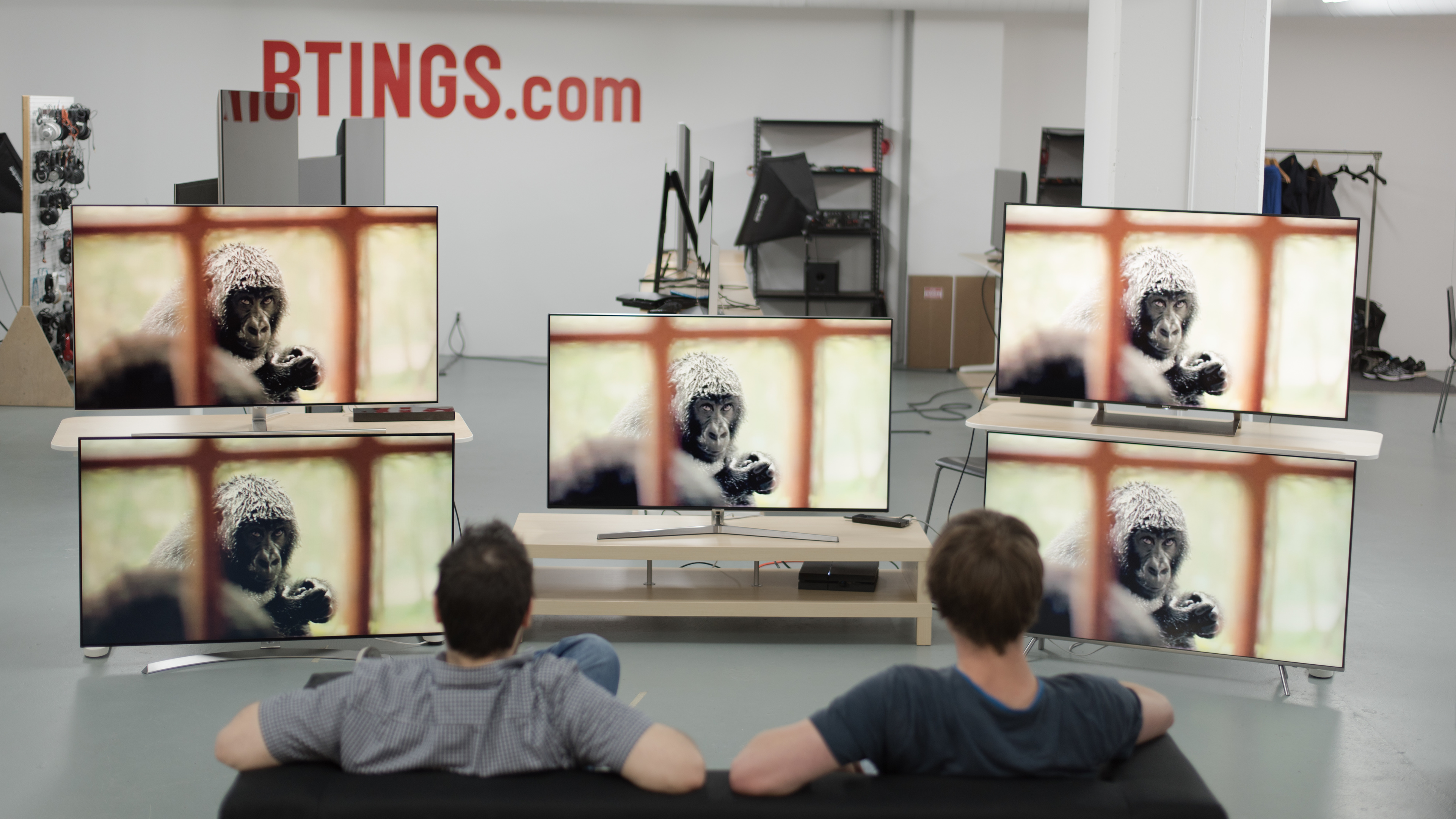
The MU9000 is a good 4k TV, but it's quite out of place in price point. It tends to perform worse than its competitors. See our recommendations for the best TVs and the best smart TVs.
The Samsung MU9000 is a bit better than the Samsung MU8000. The Samsung MU9000 has significantly better reflection handling which is evident when you watch TV shows in a brighter room. It also has a slightly better contrast that produces better blacks, which you'll appreciate when watching HDR movies in a dark room. On the other hand, the Samsung MU8000 has a marginally better response time, and this is great if you play a lot of video games.
The Sony X900E is a bit better than the Samsung MU9000. The Sony X900E has a bit better local dimming that delivers deep blacks and this is great if you watch movies in a dark room. The Sony also has a faster response time that leaves a shorter blur trail in fast action. On the other hand, the Samsung MU9000 has lower input lag for those who play video games a better reflection handling so that you can place it a bright room without issues.
The LG SJ9500 is a better choice if you have a large room with wide seating due to its wide viewing angles. For a dark room with seating directly in-front, however, the Samsung MU9000 is better. The LG SJ9500 has slightly better input lag both in SDR and HDR and this is great for gaming. On the other hand, the Samsung MU9000 has significantly better contrast ratio and somewhat better black uniformity that looks great in HDR movies in a dark room. Also, it has better SDR peak brightness and reflection handling, making it a better choice for TV shows and sports in a bright room.
The Samsung MU9000 and the Samsung NU8000 have very similar performance. The Samsung MU9000 has somewhat better reflection handling, which is great if you have a bright room with many windows. The Samsung NU8000 has a better back uniformity and delivers better dark room performance. It also has FreeSync support and lower input lag, which is great for playing video games.
Test Results
The stand of the MU9000 is similar to other Samsung TVs such as the KS9000 from 2016. It is small enough to fit on most tables and supports the TV well, although it will wobble a bit if knocked.
Footprint of the 55" TV stand: 33.7" x 13.8"
The rear of the TV looks good. Most of the inputs are located on the OneConnect box and are easy to access. The cable management is great, as the stand of the TV is used to route the cables out of the back (visible here).
The Samsung MU9000 has an excellent native contrast ratio just above 6000:1, which is great for people who have a dark home theater setup as it results in detailed dark scenes with deep blacks.
With the local dimming feature set to 'High', the contrast ratio remains almost the same, which shows the poor implementation of the local dimming on the MU9000.
Note that we could not completely turn off the local dimming feature on the MU9000, but simply set it to 'Low'.
The local dimming feature on the Samsung MU9000 is bad and is very similar in performance as on the MU8000 and Q7F. Since the MU9000 is an edge-lit TV and that the local dimming span across a large vertical zone, a large vertical blooming is visible following the moving highlight on our test video. The local dimming has 3 setting ('Low', 'Standard' and 'High') and we recommend to test each setting to see what is best for you. If you find that the screen luminance change too much depending on the on-screen content, set the local dimming to 'Low' or 'Standard'.
Great SDR peak brightness. The sustained brightness remains a good 400 - 600 cd/m² for all tests, yet local dimming is able to spike the brightness above 1000 cd/m² in an ideal case, though not for very long, as shown in the plot over time. This brightness behavior is very similar to the MU8000, but the MU9000 is a little brighter in every test.
Decent HDR peak brightness. The real scene brightness is good, and the TV's local dimming can make highlights in dark scenes even brighter, as shown by our smaller window tests. The 'Dynamic' picture mode is even brighter than the 'Movie' mode we test, as seen in the plot over time, but has less accurate picture quality.
The gray uniformity of the MU9000 is good. The edges of the TV are a bit darker, but this isn't too noticeable with normal content. The uniformity of the middle of the screen is very good, so there is very little dirty screen effect when panning over uniform sports fields. The 5% uniformity look even better than the 5%, which is very good.
Bad viewing angle, but fairly typical for a VA panel. Blacks turn gray and colors degrade when the TV is viewed from a small angle, while brightness decreases at a larger angle. People viewing the TV from the side will not have as good picture quality as people viewing from the front.
The overall black uniformity of the MU9000 is decent. On the native black uniformity test picture, some clouding is visible in the center of the screen, but it is very faint. Unlike the 2016 TVs with local dimming such as the KS8000 or KS9000, the local dimming on this TV can't be turned off. Instead, the 'native' picture was taken with local dimming set to 'low' and some vertical blooming is visible because of the edge-lit backlight.
The black uniformity picture with local dimming was taken with the local dimming set to 'High' and the same clouding that was visible on the native test picture is still there, but it is less obvious.
The MU9000 is excellent at handling reflections. It has a glossy finish, so reflections are defined but also significantly reduced in intensity. There is a minor purple tint, but it works to further reduce any reflections. This is a great result, even for a bright room.
Prior to calibration, the accuracy of the MU9000 is very good. The target gamma of Samsung TVs is a bit different to our target of 2.2, but the colors are very accurate and the white balance is good in the 'Warm2' color temperature. For most people, a calibration is not necessary.
The calibration works very well to improve the color and white balance tracking. This is a great result and results in a very accurate picture. Like other Samsung TVs, the white balance takes a bit longer to perform but the results are impressive.
You can see our recommended settings here.
Good wide color gamut, though not as wide as the KS8000 from last year. The TV can produce fairly saturated red and blue, but struggles with saturated green, though this is common for modern TVs. The TV also isn't very accurate at showing the colors its able to. The MU8000 has better accuracy and a very similar color gamut.
The TV's EOTF in the 'Movie' picture mode we test follows the HDR PQ curve very well, up until where it clips at its peak brightness. The EOTFs in Game and PC mode here and here are also very accurate, but have less peak brightness than Movie mode because local dimming is not applied.
Mediocre color volume, though only really limited by its color gamut and dark color performance. The TV shows its wide color gamut almost perfectly throughout its entire brightness range except for really dark colors. The TV's poor local dimming was unable to make our black-with-white-border slide very dark in the center, so the black point, while still good, isn't as low as a TV with good local dimming like the Sony X900E.
As with other TVs of the 2017 MU line of Samsung, the MU9000 can display how gradient test image without any banding associated with an 8-bit panel. Overall the gradient looks smooth, but there is some imperfection, mostly in the darker green color. Luckily, we did not see any major banding while looking at some particularly demanding scene from HDR movies, which is great.
We don't expect VA panels to experience permanent image retention, as the VA panel in our long-term test appears immune.
The MU9000 uses PWM at 120Hz to dim the backlight, starting at 20/20 backlight setting. Lowering the setting down to 14/20 lowers backlight amplitude, while lowering it from 13/20 shortens the duty cycle, while amplitude remains constant. Backlight that uses PWM results in duplications following moving objects but does clear up motion slightly.
Update 03/30/2018: Scaled the 'Luminosity' axis of the plots; now the Flicker-Free plots and the new BFI plot have the same 'Luminosity' axis.
Unfortunately, the 'LED Clear Motion' option doesn't reduce the BFI frequency and only dims the backlight. This is the same behaviour as the MU8000 and Q7F.
Update 03/30/2018: It was discovered that many 2017 Samsung TVs change their BFI frequency to 60 Hz when a lot of 60 Hz motion is detected on screen. The score, photo and plots have been updated.
The MU9000 has a 120Hz panel which can interpolate lower frame rate content. To do so, set 'Auto Motion Plus' to 'Custom' and increase the 'De-judder' and 'De-blur' sliders. The 'De-judder' slider affects 30 fps or lower content, and the 'De-blur' slider affects 60fps content. Note that any motion interpolation will introduce artifacts, so use a small value unless you really like the soap opera effect.
The MU9000 is able to display 24p movies from all sources with the correct cadence. To remove judder without adding the soap opera effect, set 'Auto Motion Plus' to 'Custom' and both sliders ('Blur Reduction' and 'Judder Reduction') to 0. The 'LED Clear Motion' feature is not related to judder, but to the black frame insertion feature.
Like other 2017 TVs, the MU9000 doesn't support a variable refresh rate.
Low input lag, which will please all but the most competitive gamers. Both Game mode and PC mode have low input lag, though only PC mode can show 4:4:4 color properly. The PC mode input lag is an improvement over the KS9000.
Most common resolutions are supported. 4k @ 60 Hz @ 4:4:4 or 4:2:2 color is only supported when 'HDMI UHD Color' is enabled for the input used. 4:4:4 color is only properly displayed when the input's icon is set to 'PC' (aka PC mode).
PC mode cannot be activated for some input resolutions, such as 24 Hz. The icon will still be PC, but the picture settings that are disabled in PC mode are not disabled, indicating that the TV isn't in PC mode.
Only one of Dolby Digital or DTS can be enabled at a time, the TV will not switch between them automatically.
Poor frequency response. The MU9000 shows a strong overemphasis onlower frequencies, and significant pumping and compression appears at higher volumes causing to drastically reduce clarity of content.
Subpar THD performance. The MU9000 shows significant distortion at every volume. It is free of aliasing though, which is good.
The TV did not show ads during our testing, but ads on Samsung TVs are often inconsistent. It can be assumed to have ads because all Samsung TVs since 2016 have had ads in the Smart Hub.
The TV is preinstalled with a few apps, such as Netflix, YouTube and Amazon Video. More can be downloaded from the app menu. Apps run smoothly with minimal lag.
The remote is fairly simple with few buttons, requiring the user to navigate the Smart Hub or use voice commands to do most things. It has a microphone for Samsung's excellent voice command feature, which can do numerous things like changing between inputs and apps, directly changing settings, searching for content and searching through the web browser. The remote can also be used to control other devices, even ones that do not support HDMI CEC, using Samsung's OneRemote feature.






